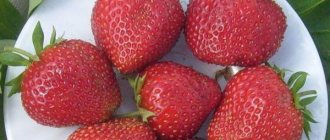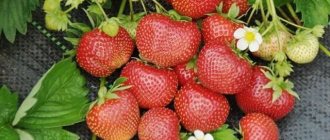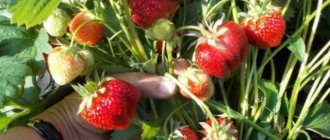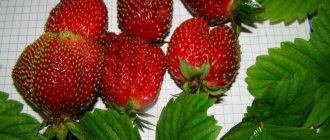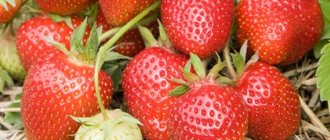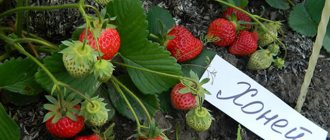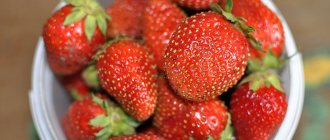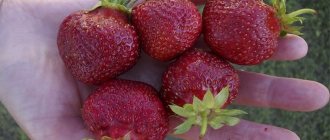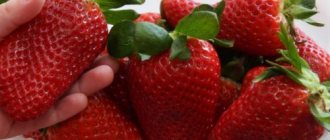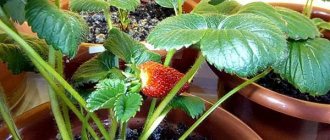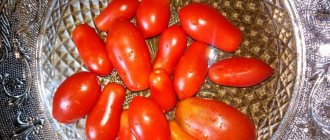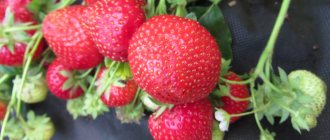Many summer residents especially like to grow berries; the Kama strawberry is very popular. With proper care of the variety, you can observe indicators such as high yield and presentation, which is confirmed by numerous photos of the harvest. And reviews from gardeners prove that the variety really deserves the attention of both beginners and professionals.
General characteristics of the Kama variety
The description of the variety should begin with the mention that Kama comes from Poland. It is artificially bred; its biological parents are the Cavalier and Zenga Zengana varieties. The well-known taste qualities and high yields are due to genetic characteristics.
Strawberry bushes are compact in size, the foliage is characterized by slightly drooping corners, and the color is dark green. A special feature of the fruit is the ability to ripen in several stages. The berries first take on a dark red hue and are considered half ripe. You can eat them, but the taste will be worse. The fruit will acquire a sweet taste when it reaches a dark burgundy color. At this stage of ripening, the variety is characterized by a bright strawberry aroma and sweet taste. The Kama strawberry variety requires immediate consumption of ripe fruits; they cannot be stored.
Strawberries of this type are early ripening fruits, which can reach 40 grams in size, but at the beginning of life the sizes sometimes exceed 70 grams. Another feature of the berry is the protection of the foliage, which protects the strawberry from birds. The flowering period is 5 weeks. The yield is quite high; up to 1 kg of crop can be harvested from one bush.
Further care for the Kama variety
Standard care for strawberries involves timely weeding of the beds, watering, and fertilizing. The bushes are treated for pests and beetles, and the tendrils are trimmed.
Watering
Young Kama strawberry bushes should be irrigated every day, preferably by sprinkling. After the seedlings take root, the frequency of watering is reduced. The crop is quite drought tolerant, but the harvest may suffer. If you regularly water the plant and mulch the beds, it will not fade even in the heat. When there is no mulch, strawberries need to be irrigated more often and loosened after each procedure. Water is poured that has settled and is at room temperature. 1 bush requires about 0.5 buckets of liquid.
Pest and disease control
In the absence of proper care, planting damaged seedlings, or unfavorable weather conditions, strawberry bushes may be attacked by insects.
- Strawberry Kama is sometimes affected by a nematode. The insect is manifested by curvature and deformation of leaves. If therapy is not started in a timely manner, the pathological process spreads to the fetuses. The disease can be eliminated if the seedling material is completely healthy. It is necessary to remove all bushes affected by the worm.
- The strawberry mite is also capable of attacking strawberry bushes and is difficult to remove. During warm, rainy summers, the parasite drinks juices from the leaves; the plant is not able to properly distribute all the nutritional components. To combat ticks, it is necessary to take preventive measures. Replant bushes every 3 years. Plant the seedlings separately, then the mite will not be able to attack all the plants at once. Before pollen, treat strawberries with Actellik.
- Weevil. The parasite prefers to feast on strawberry buds and selects the largest specimens. To destroy it, plants are treated in 3 stages. First, the bushes are sprayed with Spark. After that, Fitoferm, and the last time - Karbofos emulsion.
Among the diseases, Kama strawberry is subject to the following pathologies.
- Rot. All above-ground parts of the plant are affected by this beetle. Infection occurs when, during flowering, fungal spores located in the ground penetrate the stalk with pollen. To save the plantings, they are sprayed with copper-containing products at the beginning of the season, and the next treatment is carried out with fungicides during the active growth phase. Then, once every 10 days, the above-ground parts are sprayed with iodine solution - 10 ml per 1 bucket of water.
- Ramulariasis. The disease is characterized by the appearance of round or angular red-brown spots on the leaves. As the disease spreads, they become whitish with a purple rim. Sometimes the middle of a spot on old leaves falls out, forming a hole. On leaf petioles, pedicels, stalks, brown dots are depressed or elongated. After a while, they turn white in the center. To avoid the development of white spotting, the beds should not be allowed to become dense; in March, clear the plantation of old leaves and plant waste. After harvesting the fruits, mow the leaves and water the strawberries generously. In case of severe damage, before the start of the growing season, eradicative spraying is carried out with Nitrafen - 200 g per 10 liters of water, or 4% Bordeaux mixture. You can dilute 300-400 g of copper sulfate in 10 liters of water.
- Brown spot. Pathology causes bushes to wilt. The leaves of the Kama strawberry are covered with vague or limited veins and brownish spots. When the defeat is serious, their middles fall out. On other parts of the strawberry, the spots are oblong. Later, the center becomes whitish. In the presence of wet weather, brown spot appears from July to September. The disease develops when the beds are dense and the agricultural technology is poor. It should be dealt with in the same way as with ramulariasis.
See also
Description of Zenith strawberries, planting and care rules
Read
If you carry out preventive treatments of bushes, the risks of these problems occurring are almost zero.
Feeding
If Kama strawberries were planted in the spring, then after 2 weeks, the bushes are fertilized with organic tincture, 30 grams of superphosphate and a handful of wood ash are dissolved in 10 liters of water. The next feeding is required by the plant during the appearance of flower stalks and the first ovaries. Mullein is taken and diluted in a ratio of 1:6, or bird manure is diluted in a ratio of 1:20.
Feeding can be carried out not only root, but also foliar. Take a fermented infusion of nettle. At the end of summer, the bushes are fed with superphosphate and wood ash.
It is important that mineral compositions do not include chlorine, which negatively affects the development of strawberries. Before applying fertilizers, water the soil to prevent burning of the rhizome.
Mulching
When Kama strawberries are planted in the spring, by the end of May, the bushes are mulched with straw. This is necessary to maintain optimal temperature and moisture levels in the soil, prevent contamination of fruits, and feed the roots with organic matter due to the rotting of the straw layer. Mulch protects the soil from overheating in the summer and freezing in the winter. In addition to straw, you can use sawdust, burlap, and peat.
Loosening and removing weeds
The soil around the Kama strawberry bushes is loosened with a hoe after each irrigation or rainfall. This is important for improving soil aeration and stimulating plant growth. You should also remove weeds, they prevent the penetration of sunlight to the strawberries and take away nutrients from them.
Wintering the plant
After the leaves fall, the Kama strawberries are covered with hay, fallen leaves, and spruce branches. In regions with cold winters, plantings are covered with agronomic fiber on top. In the spring, after the threat of return of frost has been eliminated, the winter shelter is removed.
Advantages and disadvantages of the variety
Kama, like any other type of berry, has its own disadvantages and advantages. Which are important to consider when planting a species.
Gardeners include the following characteristics as the most noticeable advantages:
- early fruiting period;
- a small number of mustaches;
- long period of fruit appearance;
- drought resistance at an increased level;
- high yield while maintaining large fruits;
- presentation and resistance to transportation are acceptable.
In addition to its positive qualities, the Kama variety has a number of disadvantages. Gardeners note too much foliage and low placement of fruits. The species is more susceptible to fungus than others.
Advice! The Kama variety should not be planted in excessively salty soil. A well-lit area is ideal. In the shade, yield and quality indicators will decrease significantly.
Advantages and disadvantages
Strawberries of the Kama variety have their own positive and negative qualities, which those gardeners who want to plant them in their beds need to know about. Among the advantages of this variety are:
- early ripening of berries (in May-early June);
- long fruiting period;
- drought resistance provided that the beds are mulched;
- a small number of mustaches;
- large berry of harmonious shape;
- concentrated strawberry flavor and aroma;
- excellent yield.
Reference! Strawberries of the Kama variety received the highest score - 5 points for 3 characteristics at once - the shape and taste of the fruit and yield.
But the particular popularity of Kama variety strawberries is associated not only with its high yield, but also with the fact that it can be grown not only in ordinary beds, but also in a greenhouse, and accordingly get an extra-early harvest.
For example, in greenhouse conditions, berries from strawberry bushes can be collected as early as mid-April. This quality is worth paying attention to those gardeners who are focused on growing crops for the purpose of selling berries. This choice is also supported by the fact that in Europe Kama strawberries are grown on an industrial scale. And another advantage of the variety is remontability: strawberry bushes are able to bear fruit 1 or 2 more times per season.
Disadvantages of the variety:
- spreading bush, overdeveloped leaf mass;
- plants require a large feeding area;
- peduncles are located below the leaves;
- not resistant to white and brown spots;
- requires covering the bushes with agrofibre when there is a threat of spring frosts (flowers cannot tolerate temperatures dropping below 0°C).
All this must be taken into account when planting and caring for Kama strawberries, so that the features characteristic of it do not come as a surprise to the gardener.
Growing Tips
The Kama strawberry variety requires following simple but important planting tips:
- Before planting, it is recommended to pre-disinfect it with a weak solution of potassium permanganate.
- The ideal size of holes for planting seedlings is 26x26 cm.
- After planting, it is important not to overdo it with compacting the soil. If you overdo it, you can block the access of oxygen to the root system.
- After planting the seedlings, the berries need to be watered and an additional layer of the selected mulch should be added.
It is worth remembering that every 3 years you need to move the berries to a new place. Additional care is needed throughout life.
Planting strawberries Kama
Strawberries should be planted in a place well lit by the sun; shade is undesirable. It is impossible to place seedlings in lowlands, as moisture often accumulates there and the rhizomes may rot. It is optimal to plant bushes on flat areas where northern winds do not blow.
The best predecessors and neighbors
Prosperous neighbors of strawberries include representatives of the Cruciferous family, legumes or greens.
It is not advisable to plant berries in a place where tomatoes, cucumbers, potatoes, Jerusalem artichoke or sunflowers previously grew. They greatly deplete the soil and suck out the nutrients from it.
Preparation of seedlings of the Kama variety and beds for planting
Seedlings should be inspected for signs of disease and beetle attacks. Damaged parts of roots and shoots are removed. Seedlings are dipped in a 1% solution of potassium permanganate for disinfection, and in the root growth stimulator Epin for 2 hours.
2 weeks before planting, the soil is plowed with a shovel, weeds are removed, humus and ash are added.
It should be light, nutritious, loose, well aerated and slightly acidic. Just before planting, loosen the soil again, add wood ash, peat, and mix with the soil.
See also
Description and characteristics of Kimberly strawberries, planting and care
Read
Terms and rules of planting work
It is recommended to carry out planting work at the end of March, early April, or September. The last method is allowed for southern latitudes. Kama strawberries should take root before the onset of cold weather.
Seedlings are planted according to the scheme below:
- distance between bushes – 40-50 cm;
- depth of the planting hole – 30 cm;
- the distance between the beds is 60-80 cm.
Plantings should not be thickened, as the bushes grow strongly and need a large area for full development.
Care Tips
Additional care is almost no different from other types of berries with minor nuances. The process of watering on an abundant scale, despite the resistance of strawberries to drought, should be carried out at least once a week. In cloudy and rainy weather, watering will not be required.
Strawberries of the Kama variety are most adapted to the drip irrigation method. The plant requires the same feeding as other varieties. For example, with abundant foliage growth, the berry lacks potassium. It can be easily replenished with ash or saltpeter fertilizer.
Advantages of the Kama strawberry variety
- The variety of this garden strawberry is very early. He is not afraid of diseases.
- Easy to care for.
- The variety can be cultivated both on an industrial scale and in a summer cottage. It withstands freezing perfectly and after it does not lose either its taste or shape.
- The berries have a dense, elastic consistency. Therefore, jam and confiture are often made from Kama strawberries - they do not turn into porridge when cooked.
- The fruits have excellent keeping quality and tolerate transportation well.
- The variety is excellent for continental climates.
- Keeps well in winter.
On average, the fruits of the Kama variety strawberries correspond to the size of a matchbox, which is a rather large fruit.
The most common mistakes in care
The Kama variety, although considered one of the easiest to care for, requires knowledge of the basics and mistakes of beginners. It is novice gardeners who make a number of typical mistakes in the care and maintenance of strawberries.
- If seedlings are not disinfected in time, you can attract not only the listed pests, but also additional pests.
- Lack of measuring soil acidity before planting berries.
- If the frosts in winter promise to be too severe, you should take care of additional cover for the strawberries.
- Despite the fact that Kama strawberries easily tolerate drought, the lack of timely, abundant watering leads to drying of the root system.
As you can see, the advice is simple and clear. But it is with this kind of care that “Kama” will give the best harvest.
Strawberry Kama: description and characteristics of the strawberry variety
For those who like to enjoy fresh and tasty strawberries, you should pay attention to the Kama variety. Today it is in great demand among gardeners, because almost everyone has this amazing berry crop in their garden plot.
Description of the variety
Strawberries are of medium size, so the weight of one is 20-40 g. The foliage is dark green in color, with each leaf downward. The height of the bushes is small, the size is compact. The fruits have a classic cone shape. Their color is dark red. When the berry is fully ripe, its color changes to dark scarlet.
The flower stalks are concentrated under the leaves, so the berries are always protected from birds. If you harvest the first harvest in a timely manner, the weight of one berry can reach 60-70 g. But further harvests will not be able to please you with fruits of such impressive size. The Kama variety blooms quite early, so this period is long. Fruiting lasts 4-5 weeks.
The popularity of the Kama variety is also associated with its high yield. You can actually get up to 1 kg of ripe berries from one bush. If you plant bushes in a greenhouse, the harvest comes earlier. The first berry picking can be done in mid-April. Another advantage of the Kama variety is its remontability. It will be possible to harvest ripe berries 3-4 times during the summer. And here you can read information about the Queen Elizabeth strawberry variety.
But how to fertilize strawberries in the spring to increase the yield, and what the best means are, the information at the link will help you understand.
How strawberries are fertilized with yeast during flowering, and what results can be achieved, is described in this article.
How wood ash is used as fertilizer for strawberries, and how effective it is, is indicated here: //gidfermer.com/sadovodstvo/udobreniya-i-podkormki/zola-kak-kak-primenyat.html
You may also be interested in information on how to achieve a good strawberry harvest.
How and when to plant
If you want to get an early harvest, then you need to plant seedlings in a greenhouse. This will also make the harvest rich and of high quality. Salty soil has a bad effect on the condition of the bushes. It is best to choose a place that is well lit by sunlight. The plants grow quite powerful, but if you plant them in the shade, they will bear fruit less intensively.
When planting seedlings, you must adhere to the following rules:
- Make a hole for seedlings. At the same time, it should be quite wide and deep. You can use a 25x25 cm pattern. This will be enough for the root system to be able to freely settle underground.
- The soil around the plant should not be compacted too tightly. This will allow the roots to receive the necessary amount of oxygen.
- It is not worth planting bushes in one area for more than 3 years.
- Before planting, soak the seedlings for 10 minutes in a solution of potassium permanganate . But only for its preparation it is important not to overdo it with the concentration of the substance. The solution should take on a slightly pink color. Now rinse the seedlings with clean water and immerse them in the ground. But what kind of green manure is needed for strawberries in the spring, as they are called, is indicated here.
- Cover with earth, compact and water . You can also lay a layer of mulch using sawdust.
Common pests and diseases
The Kama strawberry is most susceptible to the influence of the nematode. The presence of a pest of this type is indicated by characteristic deformation of the foliage. The fight against such a pest lies in removing the infected part of the bush. If you do not react in time, the entire crop may suffer.
Ticks and weevils prefer to feast on the foliage of strawberries rather than the fruits. The variety can be saved with the help of special preparations that can be purchased at any gardening store.
Gardeners often notice characteristic white spots on the Kama. In narrow circles, this disease is called ramulariasis. The disease can appear anywhere strawberries are grown and its causes vary. Some blame the appearance of improper care, others see the cause in garden pests.
The methods of struggle lie in a few simple steps. You should not allow the planting to be too dense, and it is also important to promptly clear the plantation of the variety from old leaves and debris in the spring. During the period before the growing season, as a preventative measure, you can spray the berries with a solution of “nitrafen” at the rate of 200 grams of fertilizer per volume of 10 liters of water . Sometimes brown spots appear on the leaves of Kama. The methods of dealing with this disease are the same as with white spots due to the same characteristics of the disease.
Diseases and pests
The culture is resistant to many diseases. White and brown spots are considered dangerous for strawberries. To treat and prevent plants, it is necessary to use fungicides. In practice, the drug “Horus” has proven itself well.
The product is used three times during the growing season in different concentrations:
- before budding - 6 g per 10 liters of water;
- when setting fruits - 3 g per 10 liters of water;
- 1-2 weeks before harvest - 3 g per 10 liters of water.
Spraying is carried out at the rate of 5 liters per 1 hundred square meters.
Did you know? The three leaders in industrial strawberry cultivation are China, the USA and Mexico.
Among the pests, strawberry mite can infect bushes . The best remedy for the parasite is the Actellik insecticide. For use, 10 ml of the drug is diluted in 10 liters of water. 10 m² of plantings are treated with 1.5 liters of working solution. It is recommended to carry out 2 treatments with an interval of 14 days. The last spraying is carried out a maximum of 3 weeks before harvest.
Breeding Tips
Kama needs to be transplanted to a new place every 3-4 years. If you keep the variety in one place longer than expected, the yield indicators will decrease due to the reduced vitamin balance of the soil. In order to breed berries, you can use mustaches from your own plot. The age of the mother plant should not exceed 2 years.
In the autumn season, immediately after planting seedlings in a new place, gardeners recommend using complex types of fertilizers. The Kama variety does not require nitrogen supplements during this period. They can cause fungal diseases in strawberries during this period. Kama should be planted in loamy soil.
Using these tips, you can significantly increase the quality of the Kama strawberry crop.
Propagation of strawberry variety Kama
This variety reproduces by tendrils. They are taken from the mother bushes of the first year of life - this is how the strawberries will take root well. Whiskers from one-year-old young bushes take root faster and produce a good harvest. If seeds are used for propagation, many varietal qualities are lost. Planting is done according to the pattern 40-50x60-80 cm between the bushes. The distance is at least 30 cm, and it is better not to thicken it.
Kama plants are unpretentious and drought-resistant, but they benefit from drip irrigation. In hot weather, Kama does not fade with frequent watering and feels normal. The variety needs intensive agricultural technology. After planting seedlings in the fall, it is recommended to feed them with complex chelated fertilizers. You should not use nitrogen fertilizers, especially manure, because they can create a breeding ground for fungi. Every 3-4 years you need to change the planting material - all varieties of strawberries lose their quality over time.
Tip #1. The most optimal cycle for farm planting is two years. The area for strawberries should be sunny. In the shade it will grow and bear fruit much worse.
Strawberries of the Kama variety are one of the largest, therefore they are very popular both among gardeners and among lovers of this fruit.
The most suitable soil for Kama is moderately moist neutral loamy. It does not tolerate salty or acidic soil. Soil acidity can be reduced with lime. Kama will grow very well in soil whose acidity is not higher than 6 pH. Excessively acidic soil must be limed every 3-4 years. It is better to add fertilizers during the loosening process. Then they will fall deep into the soil. Before planting, seedlings are kept for 8-10 minutes in a very weak solution of potassium permanganate. Then rinse in water.
Seedlings should be planted in holes that should be quite wide and deep so that the root is completely free in the soil. There is no point in compacting the soil around plants, as the root system needs oxygen. In order for the snow to be better absorbed into the soil, its top layer is dug to a depth of at least 20-30 cm. The surface of the earth should be uneven.
There are no special requirements for caring for this berry. You just need to systematically remove weeds and mulch the soil. Regular watering is advisable. It must not dry out, otherwise the yield will be significantly reduced. It is imperative to cut off old leaves from the bush, as otherwise they will take nutrients from the plants.
Tip #2. During fruiting, Kama can be fed once a week with a weak solution of rotted watery mullein (0.5 liters of mullein per 10 liters of water).
If the bushes begin to grow poorly, they may not have enough potassium. It is found in fertilizers based on wood ash, saltpeter or sulfates. The first Kama berries ripen around June 10. Berries that have already been picked can ripen.
